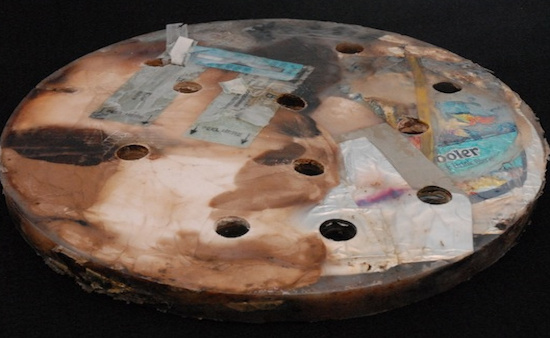Turn garbage in the universe into radiation shield
People emit garbage wherever they go, including in space - a big problem for astronauts on long journeys to other planets. However, American scientists have found a way to make space waste into something more useful: cosmic radiation shields.
Outside of Earth's low orbit, astronauts will be attacked by countless cosmic rays, increasing the risk of certain diseases such as cancer and nerve damage. And the longer the travel time in the space, the higher their risk.
The risks posed by cosmic radiation are particularly disturbing when NASA plans to explore a small, man-made planet in 2025 and bring people to Mars by 2030 (only taking a round trip to the red planet alone can last for at least 2 years).

NASA space-based garbage compactor compresses all waste crew waste
out one day into a round rubbish with a diameter of 20cm and 1.3cm thick.
According to Space, engineers at the US Aerospace Agency (NASA) are checking the effect of a sealed garbage compactor on waste water bottles, discarded clothes, duct tape and other waste in the mission of space exploration.
Not as big as portrayed in the fantasy movie "Star Wars" , the space-based garbage compactor of American scientists has made smaller, round-shaped compressed garbage pellets. 20cm and 1.3cm thick from all the waste in one day. These compressed pellets can then be stowed into a separate storage space or even used as a radiation shield for the crew on the spacecraft.
NASA officials said, compressed rubbish members can reinforce the wall of cosmic radiation around the chamber of astronauts or a small area, which was built into a storm shelter, protect the crew from signs Solar energy outbreak.
Mary Hummerick, a microbiologist at the Kennedy Space Center in Florida and a member of NASA's project, stressed: 'If the plastic component of the compostable pellets is high enough, they can be reused. use as a cosmic radiation shield for astronauts'.
Hummerick's team is trying to put the strips of bacteria containing bacteria in the compostable pellets to see the heating material (148 - 176 degrees Celsius) and the garbage compaction process of the sealed garbage compactor to kill micro bacteria or not. This is important because bacteria that survive in compressed compost can contaminate the environment containing them.
- Go on the road to find out what shield protects humanity
- Video: Radiation shield protects astronauts before the solar storm
- The invisible shield of the Earth
- Create shield from Earth-like field for spacecraft
- Clear up garbage on the vast universe
- Why not throw all the garbage into the volcano for ... convenience?
- Alarm on garbage on the universe
- Shredded 'origami' compact, folded like a paper crane but good bulletproof
- Does cell phone need 'radiation shield'?
- Recreate Big Bang radiation
- Next generation heat shield
- Creating devices can turn heat into electricity
 Van Allen's belt and evidence that the Apollo 11 mission to the Moon was myth
Van Allen's belt and evidence that the Apollo 11 mission to the Moon was myth The levels of civilization in the universe (Kardashev scale)
The levels of civilization in the universe (Kardashev scale) Today Mars, the sun and the Earth are aligned
Today Mars, the sun and the Earth are aligned The Amazon owner announced a secret plan to build a space base for thousands of people
The Amazon owner announced a secret plan to build a space base for thousands of people